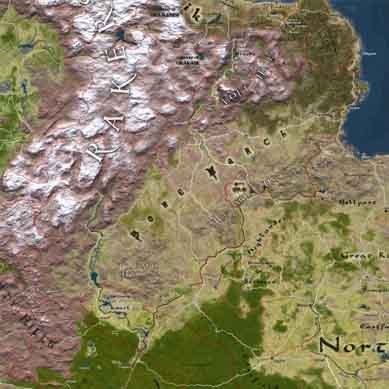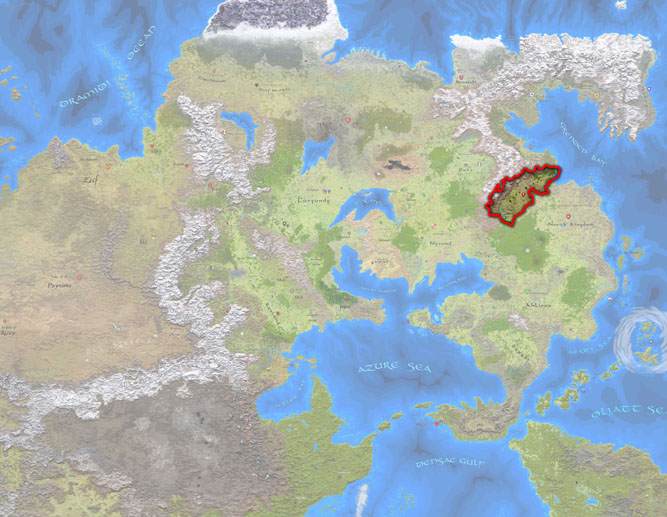Bone March
Ruled by His Nobility, Clement, the Marquis of Bone March (presumed dead)
Bone March is a small realm located north of the treacherous waters of the Teesar Torrent, nestled between the Rakers and the coast of the Solnor. While the march once held the distinction of being the northernmost frontier of Great Kingdom before the founding of Ratik, it ceased to be a part of that empire after 563 CY. Bone March is now steeped in discord, ruled by a coalition of invading nonhuman tribes, particularly orcs, gnolls, and ogres. Humanity, which once thrived here, is generally enslaved and subject to the capricious whims of petty bandit chiefs and nonhuman warlords who raid Ratik and even North Kingdom at will, going as far as Nyrond and the Flinty Hills to pillage. Nomadic bandit gangs, survivors and descendants of the once-proud human culture, prey on one and all. Only the small, autonomous county of Knurl is secure at present, aside from a handful of nearly forgotten gnome strongholds in the Blemu Hills. Knurl is ruled by Count Dunstan (LN male human Ftr9), the last noble of Bone March left in the region and an ally of Ratik. The cool, rocky farmland of Bone March is relatively poor and never supported a dense population or large cities. Its farmlands are now largely desolate wilderness. Spinecastle, from which the marquis ruled a prosperous realm before its fall, has gained an increasingly baneful reputation in the last decade. The city is a partial ruin, surrounded by armed camps of nonhumans who still rule the surrounding town, but avoid the fortress itself, which they believe is cursed. The nonhuman chieftains gather in council infrequently, acting for the most part independently of each other. They have carved up Bone March into dozens of territories that they rule as minor fiefs; in reality, their little realms are merely their normal raiding areas. The influence of North Province (now North Kingdom) has led to greater organization and military effectiveness among these barbaric tribes. The tribes from the Rakers and Blemu Hills are likely to remain in firm control of most of the march, failing an invasion by either North Kingdom (unlikely) or the concerted effort of Ratik and its allies among the Suel barbarians (who have had successes and failures here in the past). Grenell, the selfstyled "overking" of North Kingdom, covets these lands and would gladly see them under his thumb, but past alliances with the nonhumans have brought many under his own banner, and he cannot risk losing their support. His own realm is not yet solid enough for the assault, as well. Ratik harries the nonhumans, sure to punish them for any incursions to the north.History
When the Great Kingdom was young and the successors to Nasran began the westward expansion of their empire, the northern frontier quickly came to demand their notice. Seasonal raids from the Suel barbarians, which had been a nuisance for decades, suddenly tripled in size and frequency. The northernmost outpost of Johnsport and the coastal towns of Bellport and Kaport Bay became frequent and favorite targets. When it became increasingly clear that the herzog of North Province was unable to deal with the problem, Overking Manshen turned to his experienced field generals, veterans of campaigns in the west, to fortify the northern border of the realm, bypassing his ineffectual kinsman in Eastfair.
In the spring of 108 CY, Aerdi forces massed in the frontier town of Knurl. With Knight Protectors of the Great Kingdom in the vanguard, the force swept northeast, between the Rakers and the Blemu Hills, in a march to the sea. By autumn, after having been met with relatively light resistance, the Aerdi succeeded in uprooting most Fruztii encampments, and the foundations of a great stronghold were laid at Spinecastle. The Aerdi freed Johnsport in a pitched battle with the barbarians before the onset of winter. Sensing that this would be only the first phase of a long struggle, Aerdi commanders summoned thousands of contingents from North Province over the objections of the herzog, a Hextorian who had wanted to lead the forces into battle himself.
With the defeat of the Fruztii at Johnsport, the call went out that winter, and thousands of their kinsmen poured south along the Timberway the next year. Marching through passes in the Rakers, they assembled and attacked the works underway at Spinecastle, focusing their assault on the heart of the Aerdi fortifications. The defenders, including the bulk of the elite Aerdi infantry, were quickly outflanked and surrounded. A young Knight Protector of the Great Kingdom, Caldni Vir, a Heironean cavalier from Edgefield, commanded a large cavalry force patrolling the hills when the barbarian force struck. As part of the contingent led by the herzog into the north, he pivoted and headed back to Spinecastle while anticipating orders from his liege to counterattack. When the courier of the herzog delivered orders for Vir to pull back to the south in retreat, he spat in disgust and ordered the standard of the Naelax prince to be trampled in the mud. He then raised the standard of the Imperial Orb and charged.
Approaching the site of the battle from the north, he descended upon the barbarians from higher ground, and they were unprepared for the hundreds of heavy horse and lance that bore down on them in the next hour. Their lines were quickly broken, and the Imperial Army was rescued to eventually take the day in what would be called the Battle of the Shamblefield. The Aerdi drove the surviving barbarians out of the hills, controlling the land all the way to the Loftwood by the following spring. Overking Manshen recognized the courage of the young knight Vir, and raised him as the first marquis of Bone March. The land was so named for the high price paid for its taking, as the fallen imperial regulars numbered into the thousands.
For centuries, the descendants of Caldni Vir continued to rule the realm for the overkings. This durability was attributed to the general effectiveness and honor of the marquises of Spinecastle. Having survived even the Turmoil Between Crowns and constant raids from the Thillonrian barbarians, little concern was shown when nonhumans from the Rakers began raiding the nation with increasing frequency in the late 550s. In 560 CY, the raids took a dramatic upturn, and in 561 a full invasion began.
By most accounts, Clement, the last marquis of the march, was a just and effective ruler, noble and forthright, a throwback to Aerdi lords of old. He had close dealings with the archbaron of Ratik, and talk of formal alliance, even union, was always manifest. However, in what is sure to go down as black betrayal if proven true, it has been whispered that Clement's defenses were compromised by none other than His Grace Grenell, herzog of North Province. As motive, one need look no further than his ambition to annex Bone March, expanding his holdings all the way to the Rakers. Centuries of hatred between House Naelax and House Vir undoubtedly played a role as well.
In 563 CY, orcs invaded Spinecastle by secret ways that offered its defenders little warning or means of preparation. Within just three years, the nonhuman masses had laid low the nation from the outside in and the inside out, dominating the realm from Johnsport almost to the Flinty Hills. A raid into Ratik was attempted, but an alliance between Lexnol and the Fruztii prevented its success. In 580 CY, intruders from Bone March attempted an audacious act of treachery by stealing the Seal of Marner, an object blessed by the gods of the Suel barbarians that was the symbol of the new Northern Alliance. The plot was foiled when the raiding party was captured in Kalmar Pass before making it back to Spinecastle with their prize.
Infighting soon broke out between several of the nonhuman tribes, and the sides remained stalemated until 586 CY, when Alain IV, Archbaron Lexnol's son and heir, launched a raid into the fallen realm that was composed in large part of expatriates of the march, it was a doomed mission. The unusually organized nonhumans laid a trap for the force in the hills north of Spinecastle. Horrified survivors who escaped back to Ratikhill reported that the trapped raiders were dragged from their horses, torn apart, and eaten alive before their eyes. Raids into the archbarony from Bone March have resumed. In 590 CY, a full-scale assault over the Blemu Hills into Knurl was also attempted, but failed. Thus far, the defenses of the count have held firm, but he expects another wave of attacks this year.
Government: Formerly a feudal marchland of the Great Kingdom, now controlled by a conclave of nonhuman chiefs
Capital: Spinecastle
Major Towns: Knurl (13,500), Johnsport (pop. 3,500(?)), Spinecastle (pop. 6,300(?))
Provinces: (Formerly) three town-counties, nine outland-baronies, and other minor fiefs; (now) a shifting patchwork of nonhuman territories
Resources: Silver, gems (I, II)
Coinage: [Aerdy standard] orb (pp), ivid (gp), noble (ep), penny (sp), common (cp)
Population: 310,000—Human 37% (Osf), Orc 20%, Halfling 18%, Gnome 10%, Elf 7%, Half-orc 4% Halfelf 3%, Dwarf 1% (large number of uncounted goblins, gnolls, etc.)
Languages: Common, Old Oeridian, Orc, Halfling, Gnome, Elven (plus Goblin, Gnoll, etc.)
Alignments: LE*, LN, N, CE
Religions: Hextor, Oeridian agricultural gods, Erythnul, Kord, orc pantheon, Beltar
Allies: North Kingdom
Enemies: Nyrond, Ratik, Frost/Ice/Snow Barbarians
Location in the Flanaess




Comments